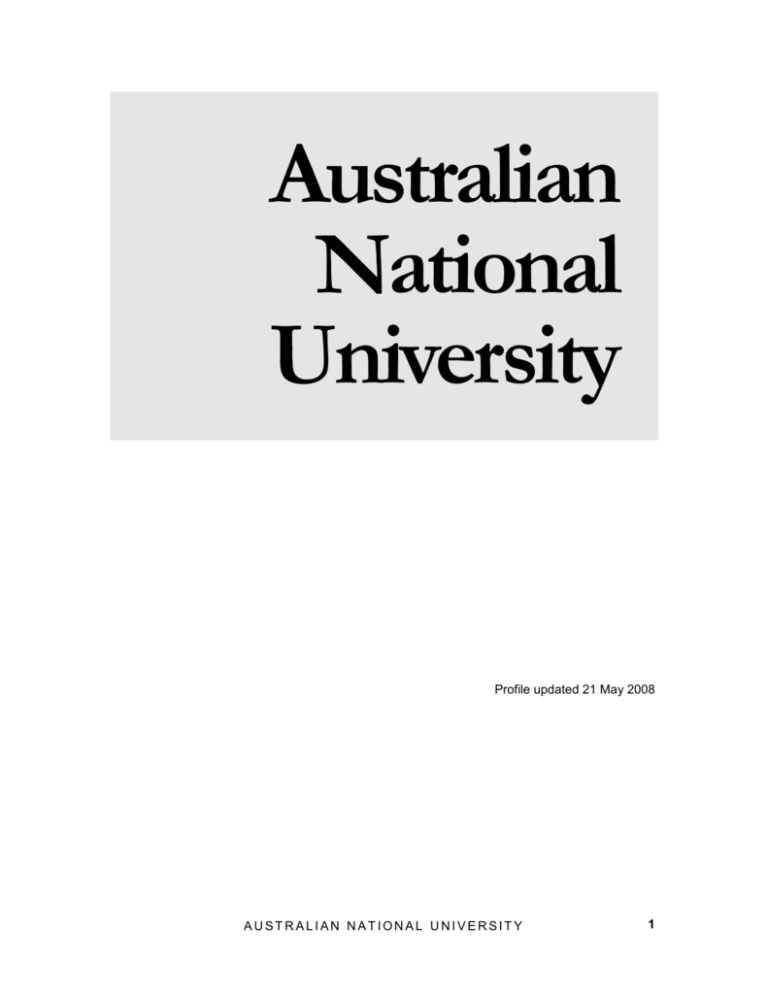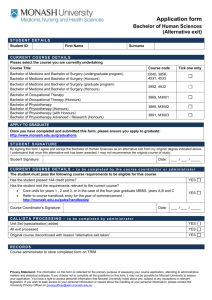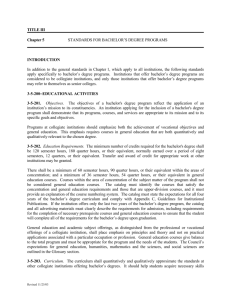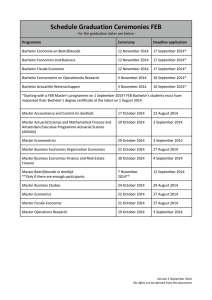Institution
advertisement

Australian National University Profile updated 21 May 2008 AUSTRALIAN NATIONAL UNIVERSITY 1 Support for this project has been provided by the Australian Learning and Teaching Council Ltd, an initiative of the Australian Government Department of Education, Employment and Workplace Relations. The views expressed in this project do not necessarily reflect the views of the Australian Learning and Teaching Council. AUSTRALIAN NATIONAL UNIVERSITY 2 Table of Contents INSTRUCTIONS .............................................................................................................................. 4 Project Definitions ......................................................................................................................................................... 4 Purpose of profile .......................................................................................................................................................... 4 Award programs described in this profile ...................................................................................................................... 4 Supporting Information .................................................................................................................................................. 4 BACHELOR OF ARTS ................................................................................................................... 5 Program Details............................................................................................................................................................. 5 Duration ...................................................................................................................................................................... 5 Current Program structure (2008) ............................................................................................................................... 5 Entry score 2001 – 2008 ............................................................................................................................................. 6 Articulation into Bachelor of Arts Program .................................................................................................................. 6 Host Faculty ................................................................................................................................................................ 6 Campus ...................................................................................................................................................................... 6 Modes of Delivery ....................................................................................................................................................... 6 Coordination/Management ......................................................................................................................................... 6 Work Integrated Learning within the Bachelor of Arts ................................................................................................... 6 Industry ....................................................................................................................................................................... 6 Graduate Attributes Shaping the Bachelor of Arts ........................................................................................................ 6 Fields of Study available to the Bachelor of Arts ........................................................................................................... 7 Student Numbers enrolled in Bachelor of Arts .............................................................................................................. 8 Review........................................................................................................................................................................... 8 Contextual Comment..................................................................................................................................................... 8 BACHELOR OF ARTS IN CONTRAST WITH OTHER ARTS PROGRAMS................................. 9 Advanced Studies and Honours .................................................................................................................................... 9 Bachelor of Philosophy (Honours) .............................................................................................................................. 9 Honours .................................................................................................................................................................... 10 Programs combined with Arts ..................................................................................................................................... 10 Bachelor of Arts Compared to Other Arts Related Programs ...................................................................................... 11 List of Tables Table 1: Trends in entry scores across years (2001 – 2008) and across campuses offering Bachelor of Arts ................................................................................................................. 6 Table 2: Fields of Study offered as possible sequences of study by campus, level and number offered as at 2008 ................................................................................................ 7 Table 3: Student numbers of total enrolment by EFTSL, numbers, and completions 2001 – 2006 ..................................................................................................................................... 8 Table 4: Numbers of Students Enrolled in Advanced Programs 2001 – 2006 .......................10 Table 5: Student numbers in combined or double degrees 2001 – 2006................................10 Table 6: Bachelor of Arts against related programs’ enrolment numbers as reported to DEST 2001 – 2006 ............................................................................................................11 Table 7: Discontinued or renamed programs ............................................................................11 AUSTRALIAN NATIONAL UNIVERSITY 3 Instructions Project Definitions For the purposes of this study, an Arts program is taken from the DEST “Society and Culture” Coding that includes 0901 Political Science and Policy Studies; 0903 Studies in Human Society; elements within 0911 Justice and Law Enforcement; 0913 Librarianship, Information Management and Curatorial Studies; 0915 Language and Literature 0917 Philosophy and Religious Studies; 0919 Economics and Econometrics and 0999 Other Society and Culture. It also includes the Creative Arts 1007 code: Communication and Media Studies. It excludes therefore programs like Bachelor of Arts (Public Relations), Bachelor of Social Work and Bachelor of Arts (Psychology). Arts programs described in this report are programs that are humanities or social sciences focused; not accredited or dependent on a professional body for benchmarking; allow some level of flexibility in terms of choice for students; and are single degree undergraduate programs. Purpose of profile This profile focuses on the award Bachelor of Arts. It is designed to provide a baseline of what Bachelor of Arts award programs look like across the Australian Higher Education Sector in 2008 and to enable benchmarking. Award programs described in this profile The first part of this profile describes the details of the award Bachelor of Arts as offered in 2008. This description is for the Bachelor of Arts award only. It does not include tagged or named programs such as Bachelor of Arts (International Studies), double degrees or honours. The second part of the profile describes the Bachelor of Arts award in contrast to other Arts awards offered by this institution fitting the definition used above. These award programs may not be offered by the same host Faculty as that which offers the Bachelor of Arts award. Supporting Information Visit the DASSH website (http://www.dassh.edu.au ) for the glossary of the terms used in this document and for aggregated datasets of the following: o o o o o o o o o o o List of Bachelor of Arts degrees and related degrees by institution Graduate attributes Work Integrated Learning Student Exchange programs Disciplines taught as part of the degree Bachelor of Arts Student demographics 2001 - 2006 Graduate destinations 2001 - 2006 Graduate satisfaction with course 2001 - 2006 AUQA reports pertaining to Bachelor of Arts degrees Projects dealing with Bachelor of Arts issues Core courses within programs AUSTRALIAN NATIONAL UNIVERSITY 4 Bachelor of Arts Program Details Duration 3 years full time. Current Program structure (2008) A Bachelor of Arts program must include units with a value totalling no fewer than 144 credit points and normally not more than 150 credit points and must also include: no more than 48 credit points from level 1 units; no fewer than 96 credit points from later year units offered level 2 and 3; no fewer than 96 credit points offered by the Faculty of Arts the completion of at least two majors, consisting of either: o two Arts majors - the two Arts majors cannot have the same name; or o one Arts major and one major from another Faculty (except the Law Faculty). The out-of-Faculty major must be identified as a major by the other Faculty and completed according to their rules. An Arts major consists of a minimum of 42 credit points generally comprising: o a maximum of 12 credit points from units offered at level 1(generally 2 units); and o a minimum of 30 credit points from later year units offered at level 2 and 3 (generally 5 units). A typical study plan for each level is as below: Level 1 (48 units) o A maximum of 12 credit points from each of the two majors in level 1 units (24 credit points in total) o A maximum of 24 credit points of any level 1 Arts units Level 2 (48 units) o A minimum of 18 credit points from each of the two majors in later year units (36 credit points in total) o A minimum of 12 credit points from any higher level Arts units (level 1 units not allowed) Level 3 (48 units) o A minimum of 12 credit points from each of the two majors in later year units (24 credit points in total) o A minimum of 24 credit points from any higher level Arts units (level 1 units not allowed) AUSTRALIAN NATIONAL UNIVERSITY 5 Entry score 2001 – 2008 Table 1: Trends in entry scores across years (2001 – 2008) and across campuses offering Bachelor of Arts Type UAI / ENTER / TER 2001 73 2002 70 2003 76 2004 80 2005 85 2006 83 2007 75 2008 75 Articulation into Bachelor of Arts Program There are no formal articulation arrangements. Credit transfer/status is considered on an individual case-by-case basis. Host Faculty Faculty of Arts Campus Main Modes of Delivery On campus only Coordination/Management The Coordination role is not filled by one person. There are three full time Coursework Officers, a Deputy Manager and a Manager in the College Student Office as well as the Dean of the College. Each major also has a convener who overseas the specific academic requirements of the major. Each discipline offering an Honours year also has a convenor. The management and coordination of the degree is through the cooperation of these offices. Work Integrated Learning within the Bachelor of Arts Industry The Australian National Internship Program is administered within the College of Arts & Social Sciences, but is available to students from all degrees across the University. The program places students with government departments, working with parliamentarians and working with NGOs. Program credit is given for internships. There are also Faculty based internships, for example in Art History, Development Studies, Film Studies and Drama. Placements all reflect the field of study being studied. There is a shell unit which allows Arts students to do internships on an ad hoc basis but still receive credit for it. Graduate Attributes Shaping the Bachelor of Arts Aims of a Bachelor of Arts education To be essentially transformative in nature, asking students to question or explore fundamental values as much as to acquire skills and knowledge; To seek to provide students with multiple perspectives on the world, as they see it, through a range of disciplinary lenses; To require students to think globally and historically rather than in the here-and-now; To develop students’ ability to think critically and creatively, and express their ideas through writing and in other media. AUSTRALIAN NATIONAL UNIVERSITY 6 Fields of Study available to the Bachelor of Arts Fields of study are defined in this profile as a subject or discipline area; a branch of knowledge or learning. Majors have been collated to match to a field of study to provide a sense of a subject area in which a major is offered. These fields of studies have been renamed to allow for a global sector-wide overview. Table 2: Fields of Study offered as possible sequences of study by campus, level and number offered as at 2008 Campus offered Level offered Field of Study # offered Canberra Major American Studies 1 Ancient Greek 1 Anthropology 3 Arabic 1 Archaeology 1 Art History 2 Art Theory 1 Australian Studies 1 Classical Studies 1 Development Studies 1 Drama 1 English 1 Environmental Studies 1 European Studies 1 Film Studies 1 French 1 Gender Studies 1 Geography 1 German 1 Health, Medicine & the Body 1 History 1 Human Ecology 1 Human Sciences 1 Indigenous Studies 1 International Communications 1 International Relations 1 Italian 1 Latin 1 Linguistics 2 Musicology 1 Persian 1 Philosophy Policy Studies 1 Political Science 1 Population Studies 1 Religious Studies 1 Social Research Methods 1 Sociology 1 Spanish 1 Turkish 1 Total number of sequences of study offered 44 Source: Web site and publicity materials accessed June 2007 and updated February 2008 AUSTRALIAN NATIONAL UNIVERSITY 7 Student Numbers enrolled in Bachelor of Arts Table 3: Student numbers of total enrolment by EFTSL, numbers, and completions 2001 – 2006 2001 2002 2003 2004 Total Student Numbers 1021 1041 949 937 Total EFTSL 660.82 692.89 655.03 640.48 Total Program Completions 206 170 149 187 Source: DEST data set, developed October 2007 and updated February 2008 2005 882 630.19 216 2006 801 556.00 195 Review The Bachelor of Arts was reviewed in early 2007. The review was transformative in that it established a framework of systematic review of the majors and units in the Bachelor of Arts. The review looked at how to increase flexibility in the program and how to ensure quality in education. From time to time fields of study and the faculty are also reviewed. Contextual Comment The majors listed above are only those that are offered in the Bachelor of Arts and named Bachelor of Art’s within the College of Arts and Social Sciences, however there is also a series of degrees and majors offered by the College of Asia and the Pacific that might normally be offered within the Bachelor of Arts program at other universities. Majors offered within the College of Asia and the Pacific include: Chinese, Hindi, Indonesian, Japanese, Japanese Linguistics, Korean, Sanskrit, Thai, Urdu/Persian, Vietnamese, Asian History, Asian Religions, Asian Literature, Asian Politics & International Relations, Contemporary Asian Societies and Security Studies, Statistics and details of these offerings are not included in this profile. AUSTRALIAN NATIONAL UNIVERSITY 8 Bachelor of Arts in contrast with other Arts Programs Advanced Studies and Honours Bachelor of Philosophy (Honours) The PhB program is an elite program and is structured so that students are treated as honours students (ie Researchers in training) from the start The Bachelor of Philosophy (Honours) is a research-focused program at ANU. It is an integrated program leading to an Honours award. It is designed for intellectually ambitious students who aspire to study at the highest level. Every student receives intensive individual attention from an academic advisor. The PhB is flexible in its structure with the program determined each year in collaboration with the academic advisor and the Assistant Dean (Honours & PhB). One quarter of the student’s studies in the first three levels consists of individually tailored advanced studies units specifically designed to provide them with a strong base in research. In the fourth year the student undertakes an Honours year centred around one Arts field of study. It is possible to accelerate the program and complete it in three years by taking extra units at Level 1 and by undertaking Advanced Studies or internship units in breaks. (Source: http://studyat.anu.edu.au/programs/4140HBPHIL;overview.html) Program structure The program normally requires completion of at least 192 credit points approved by the Faculty of Arts on the recommendation of the PhB Convenor with which the candidate’s academic advisor is associated, including: o No more than 48 credit points from units from units offered at level 1 o A minimum of 96 credit points from units from units offered at level 2 and 3 o A minimum of 96 credit points from units from units offered by the Faculty of Arts; o Completion of a minimum of 60 credit points in an Arts field of study, with the approval of the Assistant Dean (Honours & PhB) to meet eligibility requirements for entry to Honours; o Completion of a major from a second field of study, either within the Arts Faculty OR a major from another Faculty; o Completion of a minimum of 36 credit points of Advanced Studies units ARTS1101, ARTS1102, ARTS2101, ARTS2102, ARTS3101, ARTS3102; and o An Honours year to the value of 48 credit points in a field of study within the Faculty of Arts and completed at first class honours level. Specific Requirements/ Limitations To qualify for this program, a student needs to complete all of the program requirements, at High Distinction level, and complete the Honours year with first class honours. After completion of the AUSTRALIAN NATIONAL UNIVERSITY 9 equivalent of each 48 units for the program, the Faculty will determine whether the student’s level of performance is sufficient to remain in the program. It is possible to transfer to another undergraduate program of the Faculty and receive credit for work successfully completed in the PhB. A strict quota applies to enrolments in this program. Honours The Honours program is an advanced level of study designed to allow students to specialise their knowledge in one of three options: (1) Single honours – study in one area of specialisation (2) Combined honours – study in two areas of specialisation; or (3) Double honours – two single honours programs Students accepted into an Honours program undertake Level 4 coursework and a research thesis. Eligibility In order to be eligible for admission to Honours, the Faculty of Arts requires students fulfil the following minimum criteria: (a) Completion of the requirements for the Bachelor of Arts pass program; and (b) Completion of 10 units (at least 60 credit points) with the appropriate level of grades and prerequisite units (if applicable) that has been prescribed by the specific Honours program for single Honours (ie a major (7 units) + 3 further later year courses). (c) Completion of 8 unit (at least 48 credit points) with the appropriate level of grades and prerequisite units (if applicable) that has been prescribed by two Honours programs for combined Honours i.e. 16 units (96 credit points). Table 4: Numbers of Students Enrolled in Advanced Programs 2001 – 2006 2001 2002 2003 2004 Program 22 89 94 Bachelor of Arts (Honours) Bachelor of Arts (European Studies) 1 1 (Honours) Bachelor of Philosophy (Honours) Bachelor of Arts (Australian Studies) 1 (Honours) Bachelor of Arts (Development 3 1 Studies) (Honours) Bachelor of Arts (International 1 4 4 Relations) (Honours) Bachelor of Arts (Policy Studies) 1 2 (Honours) Source: DEST data set, developed October 2007 and updated February 2008 2005 100 2006 103 17 27 1 1 5 8 Programs combined with Arts The following table lists students enrolled in a compound degree program. This may include dual, combined and double degrees as reported to DEST by institutions. They have been listed in order of popularity. Table 5: Student numbers in combined or double degrees 2001 – 2006 Program Combination Arts / Asian Studies Arts / Commerce 2001 157 100 2002 192 192 2003 113 125 AUSTRALIAN NATIONAL UNIVERSITY 2004 195 133 2005 177 153 2006 179 152 10 Arts / Economics 75 94 Arts / Forestry 4 Arts / Info Technology 16 Arts / Laws 566 637 611 Arts / Music Arts / Psychology 79 137 166 Arts / Science 299 276 257 Arts / Science (Forestry) 8 Arts / Science (Psychology) 137 Arts / Visual Arts 23 28 36 Arts/Social Work* Asian Studies / Arts 4 78 Engineering / Arts 4 8 12 Source: DEST data set, developed October 2007 and updated February 2008 82 79 67 12 652 2 133 248 6 52 39 14 689 4 96 223 9 66 46 11 647 6 59 182 7 86 39 13 15 17 * The Bachelor of Arts/Bachelor of Social Work is a dual degree offered in conjunction with the Australian Catholic University – Bachelor of Arts (ANU) and Bachelor of Social Work (ACU) Bachelor of Arts Compared to Other Arts Related Programs This table compares the award Bachelor of Arts to other programs that fit the description of Arts (see page 1) Table 6: Bachelor of Arts against related programs’ enrolment numbers as reported to DEST 2001 – 2006 Degree program Bachelor of Arts Other Arts programs Bachelor of Arts (Art History & Curatorship) Bachelor of Arts (Development Studies) Bachelor of Arts (European Studies) Bachelor of Arts (International Relations) Bachelor of Arts (Policy Studies) Bachelor of Asian Studies Bachelor of Arts (Mew Media Arts) Bachelor of Asian Studies (Specialist) Total 2001 1021 2002 1041 2003 949 2004 937 2005 882 2006 801 44 67 53 46 39 28 29 14 19 108 27 12 78 13 95 22 13 144 11 130 24 10 202 10 127 68 1303 58 1391 54 1376 55 1411 19 6 235 9 123 8 48 1369 16 7 248 8 122 10 27 1267 Table 7: Discontinued or renamed programs 2001 2002 2003 Arts Programs renamed or discontinued Bachelor of Arts (Australian Studies) 4 3 Source: DEST data set, developed October 2007 and updated February 2008 AUSTRALIAN NATIONAL UNIVERSITY 2004 2005 2006 11





